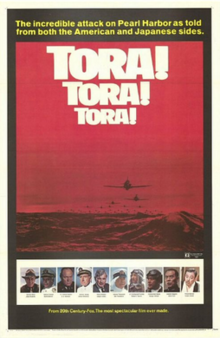
Back Tora! Tora! Tora! AN تورا! تورا! تورا! (فيلم) Arabic تورا! تورا! تورا! ARZ تورا! تورا! تورا! AZB Тора! Тора! Тора! Bulgarian Tora! Tora! Tora! Catalan Tora! Tora! Tora! Welsh Tora! Tora! Tora! Danish Tora! Tora! Tora! German Τόρα! Τόρα! Τόρα! Greek
| Tora! Tora! Tora! | |
|---|---|
 Theatrical release poster | |
| Directed by | American sequences Richard Fleischer Japanese sequences Toshio Masuda Kinji Fukasaku Akira Kurosawa (uncredited) |
| Screenplay by | American sequences Larry Forrester Japanese sequences Hideo Oguni Ryūzō Kikushima Akira Kurosawa (uncredited) |
| Based on |
|
| Produced by | Elmo Williams |
| Starring | |
| Cinematography | American sequences Charles F. Wheeler Japanese sequences Shinsaku Himeda Masamichi Satoh Osamu Furuya |
| Edited by | James E. Newcom Pembroke J. Herring Inoue Chikaya |
| Music by | Jerry Goldsmith |
Production companies | Williams-Fleischer Productions Toei Company |
| Distributed by | 20th Century Fox (U.S.) Toei Company (Japan) |
Release dates |
|
Running time | 144 minutes |
| Countries | United States Japan |
| Languages | English Japanese |
| Budget | $25 million[1][2] |
| Box office | $37 million (rentals)[3] |
Tora! Tora! Tora! (Japanese: トラ・トラ・トラ!) is a 1970 epic war film that dramatizes the events leading up to the Japanese attack on Pearl Harbor in 1941, from the American and Japanese positions. The film was produced by Elmo Williams and directed by Richard Fleischer, Toshio Masuda and Kinji Fukasaku, and stars an ensemble cast including Martin Balsam, Joseph Cotten, So Yamamura, E.G. Marshall, James Whitmore, Tatsuya Mihashi, Takahiro Tamura, Wesley Addy, and Jason Robards. It was Masuda and Fukasaku's first English-language film, and first international co-production. The tora of the title, although literally meaning "tiger", is actually an abbreviation of a two-syllable codeword (i.e., totsugeki raigeki 突撃雷撃, "lightning attack"), used to indicate that complete surprise had been achieved.[4]
The film was released in the United States by Twentieth Century Fox on September 23, 1970, and in Japan by the Toei Company on September 25. It received mixed reviews from American critics, but was praised for its historical accuracy and attention to detail, its visual effects, and its action sequences.[5][6] Tora! Tora! Tora! was nominated for five Oscars at the 43rd Academy Awards, including Best Cinematography and Best Film Editing, winning Best Visual Effects (L.B. Abbott and A.D. Flowers).[7] The National Board of Review ranked it in its Top Ten Films of 1971. A 1994 survey at the USS Arizona Memorial determined that for Americans the film was the most common source of popular knowledge about the Pearl Harbor attack.[8]
- ^ Cite error: The named reference
Parish p. 411was invoked but never defined (see the help page). - ^ Solomon, Aubrey. Twentieth Century Fox: A Corporate and Financial History (The Scarecrow Filmmakers Series). Lanham, Maryland: Scarecrow Press, 1989. ISBN 978-0-8108-4244-1. p256
- ^ Cite error: The named reference
Foxwas invoked but never defined (see the help page). - ^ "15 Things You Might Not Know about Pearl Harbor - AOP Homeschooling". www.aop.com. Retrieved 2023-06-19.
- ^ Cite error: The named reference
Aviation Great filmswas invoked but never defined (see the help page). - ^ Cite error: The named reference
:0was invoked but never defined (see the help page). - ^ Cite error: The named reference
Orriss p. 200was invoked but never defined (see the help page). - ^ Cite error: The named reference
:1was invoked but never defined (see the help page).